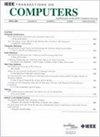节能和隐私意识mec支持IoMT健康监测系统
IF 3.8
2区 计算机科学
Q2 COMPUTER SCIENCE, HARDWARE & ARCHITECTURE
引用次数: 0
摘要
医疗物联网(IoMT)的进步使得远程患者监测越来越可行。然而,在保护敏感数据、优化资源和解决患者设备的能源限制方面,挑战仍然存在。本文提出了一个集成移动边缘计算(MEC)和第六代(6G)技术的健康监测框架,该框架被构建为内部医疗体域网络(int- mban)和mban之外的外部通信(ext- mban)。对于int- mban,本文提出的OptiBand算法优化了能耗,延长了设备待机时间,并考虑了消息及时性和医疗危机性。OptiBand的一项关键创新是将患者的设备待机时间纳入资源分配策略,以满足现实世界患者的需求。对于ext-MBANs, DynaMEC算法动态平衡能源效率、隐私保护、延迟和公平性,即使在不同的患者规模下也是如此。还引入了延迟感知调度机制,以保证及时完成紧急任务。理论分析和实验结果证实了两种算法的可行性、收敛性和最优性。该系统的这些特点和优势使得通过IoMT进行患者远程监护更加可行和有效。本文章由计算机程序翻译,如有差异,请以英文原文为准。
An Energy-Efficient and Privacy-Aware MEC-Enabled IoMT Health Monitoring System
Advancements in the Internet of Medical Things (IoMT) have made remote patient monitoring increasingly viable. However, challenges persist in safeguarding sensitive data, optimizing resources, and addressing the energy constraints of patient devices. This paper presents a health monitoring framework integrating Mobile Edge Computing (MEC) and sixth-generation (6G) technologies, structured into internal Medical Body Area Networks (int-MBANs) and external communications beyond MBANs (ext-MBANs). For int-MBANs, the proposed OptiBand algorithm optimizes energy consumption, extends device standby time, and considers message timeliness and medical criticality. A key innovation of OptiBand is its incorporation of patient’s device standby time into the resource allocation strategy to address real-world patient needs. For ext-MBANs, the DynaMEC algorithm dynamically balances energy efficiency, privacy protection, latency, and fairness, even under varying patient scales. A latency-aware scheduling mechanism also be introduced to guarantee timely completion of emergency tasks. Theoretical analysis and experimental results confirm the feasibility, convergence, and optimality of both algorithms. These characteristics and advantages of the proposed system make remote patient monitoring through IoMT more feasible and effective.
求助全文
通过发布文献求助,成功后即可免费获取论文全文。
去求助
来源期刊

IEEE Transactions on Computers
工程技术-工程:电子与电气
CiteScore
6.60
自引率
5.40%
发文量
199
审稿时长
6.0 months
期刊介绍:
The IEEE Transactions on Computers is a monthly publication with a wide distribution to researchers, developers, technical managers, and educators in the computer field. It publishes papers on research in areas of current interest to the readers. These areas include, but are not limited to, the following: a) computer organizations and architectures; b) operating systems, software systems, and communication protocols; c) real-time systems and embedded systems; d) digital devices, computer components, and interconnection networks; e) specification, design, prototyping, and testing methods and tools; f) performance, fault tolerance, reliability, security, and testability; g) case studies and experimental and theoretical evaluations; and h) new and important applications and trends.
 求助内容:
求助内容: 应助结果提醒方式:
应助结果提醒方式:


